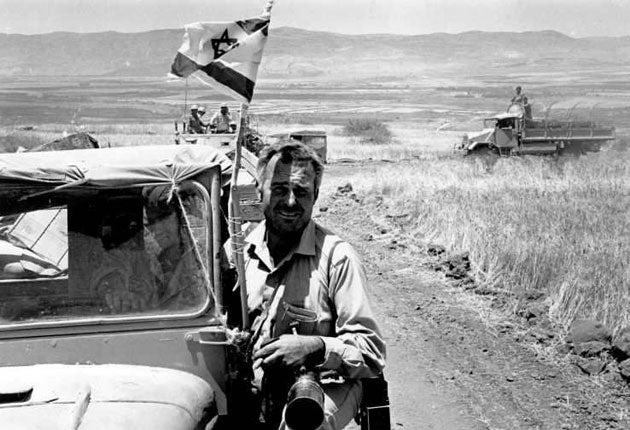Terry Fincher: Award-winning photographer who covered Suez and the Vietnam war

Terry Fincher excelled at photographing both war and peace, working at times on battlefields and at times capturing images of statesmen and film stars in a career that encompassed the Suez crisis and Princess Diana. He dominated the Fleet Street papers of his day, winning a hatful of awards and establishing himself as the Street's top photographer. Although he will probably be best remembered as a war photographer, especially for his work in Vietnam, his versatility was such that he could cover anything.
Terence Fincher was born in Buckinghamshire in 1931, and was raised in Putney by his English father and Irish mother. The family did not have much money: Fincher would recall having to stuff cardboard into his battered shoes to keep out the rain. As a youth, while working as an electrician's mate, he would wander up to Fleet Street, intrigued by its air of busyness. A formative moment came when he saw a photographer rushing off from a newspaper office, and he became determined that one day he would do the same.
His mother bought him a second-hand camera which he carried everywhere, and this provided him with an early break. Taking the bus home one day, he spotted a policeman holding up traffic to allow a swan to waddle across Putney Bridge. He instantly took a snap, which was published in all the London newspapers. A job followed as a messenger boy with the Keystone Press Agency, and he was on his way.
After some years working in London, he was sent to cover the Suez crisis, an assignment which produced poignant photographs of a bereaved mother. His first major award, as British Photographer of the Year, followed. After several years on the Daily Herald he joined the Daily Express in 1961. The paper introduced a weekly page, "The Fincher File", that showcased both his work and that of other photographers.
Having made his name with the Suez invasion, Fincher was despatched to many conflicts in the years that followed, including those in India, Pakistan, Nigeria, Cyprus, Aden, Biafra and Northern Ireland. But he did his best, and probably most dangerous, work in Vietnam, where he went on assignment on five occasions. There, he spent much time on the front line with American troops, often under heavy fire.
In his classic anecdote from his Vietnam years, Fincher recalled sharing a trench with the photographer Larry Burrows, of Life magazine. Fincher remembered: "That night it was pitch black and the rockets and shells were coming in thick and fast, landing even closer than the previous night. I tried to sleep through the noise, covering my face with my steel helmet, but it was impossible."
Fincher wondered whether to opt for helicopter evacuation to escape the war zone, by now strewn with the bodies of American soldiers. He remembered: "In the morning I asked Larry what we should do that day. He looked up at the dark, brooding sky. 'Exposure one second at f2.8,' he said with a grin." (Burrows later died when his helicopter was shot down over Laos.)
A particular scoop came in 1968 when Charlie Wilson, one of the Great Train Robbers, was arrested in Canada. As a teenager Fincher had hung around with Wilson and other criminals, known as the Elephant Gang because they socialised around the Elephant and Castle. Fincher got himself on the plane carrying Wilson home and was allowed to photograph him, leaving rivals green with envy.
Fincher was British press photographer of the year for 1957, 1959, 1964 and 1967, as well as winning other prizes. In 1970 he moved on from the Express; with his wife, June, and their daughters he set up Photographers International, an agency that supplied material to a wide range of papers. His thousands of subjects included Mother Teresa, Bing Crosby, Marilyn Monroe and Charlie Chaplin, but the agency specialised in the royal family: he and his daughter Jayne, also a noted photographer, eventually became very friendly with Princess Diana.
Those who knew him recalled his gentlemanly manner, one acquaintance saying: "I learned a lot from Terry. He was a kind and gentle man and always had time for us to have a chat about photography." The Express picture editor Neil McCarthy said: "His pictures were a tribute to his expertise and to his bravery."
The photographer Bob Aylott described him as "the finest Fleet Street photographer I ever encountered". He added: "His ruthless competitiveness, quick thinking and foresight kept him ahead." An exhibition of his work was staged at the Getty Images gallery in London earlier this year.
David McKittrick
Terence Edgar Fincher, photographer: born Aylesbury, Buckinghamshire 8 July 1931; married 1955 June Smith (deceased; three daughters) died Blackheath, Surrey 6 October 2008.
Subscribe to Independent Premium to bookmark this article
Want to bookmark your favourite articles and stories to read or reference later? Start your Independent Premium subscription today.

Join our commenting forum
Join thought-provoking conversations, follow other Independent readers and see their replies